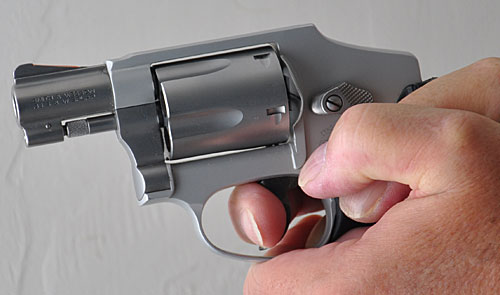 The drunk was standing knee deep in the horribly polluted Tijuana River. He swigged from his bottle of liquid courage and profanely challenged a Border Patrol agent to come in and get him. There’s no reasoning with a drunk so the agent decided to convince the loco of the error of his ways with a small demonstration. Quickly drawing his .357 Magnum, the agent fired and blew the tequila bottle to pieces. As the drunk stared in disbelief at the bottle neck in his hand the agent fired two more rounds, drenching the drunk in twin columns of sewage. Calmly flicking open the cylinder and reloading, the agent asked the dripping drunk if, perhaps, he was ready to come out of the river?
The drunk was standing knee deep in the horribly polluted Tijuana River. He swigged from his bottle of liquid courage and profanely challenged a Border Patrol agent to come in and get him. There’s no reasoning with a drunk so the agent decided to convince the loco of the error of his ways with a small demonstration. Quickly drawing his .357 Magnum, the agent fired and blew the tequila bottle to pieces. As the drunk stared in disbelief at the bottle neck in his hand the agent fired two more rounds, drenching the drunk in twin columns of sewage. Calmly flicking open the cylinder and reloading, the agent asked the dripping drunk if, perhaps, he was ready to come out of the river?
This scene may or may not have played out many years ago, but, regardless, I have always been a revolver kind of guy. These days’ revolver sales are booming, so let’s see if I can offer a little wisdom on the subject.
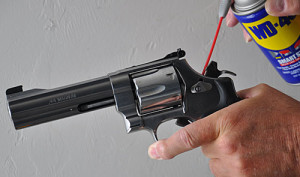
Clean It
Revolvers need to be kept clean and sparsely lubricated, as excessive lube attracts dirt. I learned this lesson while patrolling the border astride an off road ATV with a .357 Magnum strapped to my hip. Dirt, and especially sand, can put a revolver out of action by making it difficult to open and close the cylinder or by keeping the cylinder from rotating freely. If you carry a small revolver in a pocket it won’t take long for lint to work its way into all the nooks and crannies but it can be removed quickly with a toothbrush or blown out with compressed air.
Revolvers usually require only routine barrel and chamber cleaning. Unless put in heavy service under harsh conditions, it is rarely necessary to disassemble and clean the internal parts of a revolver – I would guess most revolvers are never disassembled. One other caution: don’t squirt oil or solvent down into the action thinking this will help clean it or smooth the internal parts. It won’t, and will cause crud to stick to the oil and build up quickly.
Smooth It
Whether due to product liability concerns or other reasons some revolvers don’t come from the factories these days with a smooth, light double action (DA) trigger pull. Notable exceptions are the new Ruger LCR and Smith & Wesson Bodyguard snub-nosed revolvers. Back in the “good old days” we were accustomed to cutting springs and backing off mainspring screws in order to get a light trigger pull but this was never a good idea. Now, these steps are unnecessary due to the availability of replacement spring kits from outfits like Wolff Gun Springs and Apex Tactical.
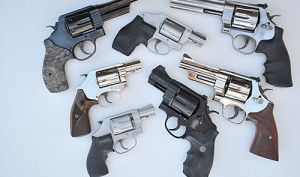 Fit It
Fit It
Any handgun needs to fit the shooter’s hand. Because there are so many variations in grip size and shape available for wheel guns getting a proper fit is easy. Revolver grips are made in materials ranging from traditional wood to soft recoil absorbing rubber, and custom makers can make grips sized to a specific hand. Hogue, Pachmayr and Eagle offer grips in many styles and materials while outfits like Herrett’s offer standard as well as custom fitted grips. Small custom operations like Esmeralda offer beautiful grips in many exotic woods. Getting the fit you need while dressing up your revolver has never been easier. Crimson Trace makes Lasergrips for most revolvers and I find them particularly useful on the smaller revolvers with fixed sights.
Reload It
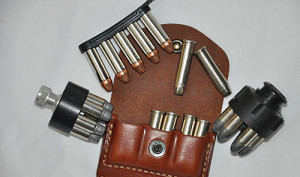 Speed loaders are devices holding the correct amount of ammunition to recharge all the chambers at once. Ammunition for loading one round at a time can be carried in loops or pouches on the belt, or in devices called Speed Strips and Tuff Strips, these being strips of rubber material holding ammunition by the rim so it can be peeled off the strip and dropped into the chamber. Always use gravity to your advantage – when unloading, point the barrel up, and when loading point it straight down.
Speed loaders are devices holding the correct amount of ammunition to recharge all the chambers at once. Ammunition for loading one round at a time can be carried in loops or pouches on the belt, or in devices called Speed Strips and Tuff Strips, these being strips of rubber material holding ammunition by the rim so it can be peeled off the strip and dropped into the chamber. Always use gravity to your advantage – when unloading, point the barrel up, and when loading point it straight down.
The most commonly used speed loaders come from HKS and Safariland, while strip loaders are available from Bianchi and Tuff Products. Leather ammunition pouches are available from many outfits including Galco Gunleather.
Grip It
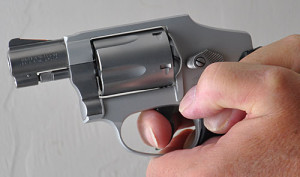 How you hang onto the revolver during firing has a lot to do with how well you can control the trigger and keep the sights on target. Especially in DA shooting, a strong grip is necessary to keep the sights aligned while the trigger is moving. This is best accomplished with the thumbs locked down, one over the other. This grip also avoids allowing the support side thumb to line up with the barrel/cylinder gap and be damaged by escaping gases as might happen with a “thumbs forward” grip.
How you hang onto the revolver during firing has a lot to do with how well you can control the trigger and keep the sights on target. Especially in DA shooting, a strong grip is necessary to keep the sights aligned while the trigger is moving. This is best accomplished with the thumbs locked down, one over the other. This grip also avoids allowing the support side thumb to line up with the barrel/cylinder gap and be damaged by escaping gases as might happen with a “thumbs forward” grip.
Sight It
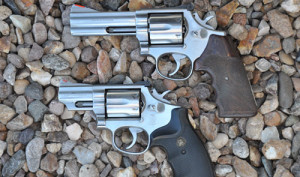 You have to see the front sight to get hits. Coloring the sight or replacing it with one you can see is a very good idea. In the case of revolvers with fixed, non-replaceable front sights, a touch of paint or colored nail polish can be used to add color and make seeing the front sight easier and quicker. Replaceable front sights are available in colors ranging from red to fluorescent green and big, white, easy to see, glow in the dark night sights are available from XS Sights.
You have to see the front sight to get hits. Coloring the sight or replacing it with one you can see is a very good idea. In the case of revolvers with fixed, non-replaceable front sights, a touch of paint or colored nail polish can be used to add color and make seeing the front sight easier and quicker. Replaceable front sights are available in colors ranging from red to fluorescent green and big, white, easy to see, glow in the dark night sights are available from XS Sights.
Feed It
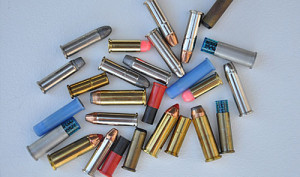 You can shoot wax, plastic and rubber bullets, birdshot, target ammunition, full powered hunting and defensive ammunition and multiple projectile loads in wheel guns. As opposed to semi-automatic pistols, revolvers are not picky about bullet shape. This variation in ammunition makes revolvers the most versatile of handguns and lets you choose exactly the load you need for any specific purpose.
You can shoot wax, plastic and rubber bullets, birdshot, target ammunition, full powered hunting and defensive ammunition and multiple projectile loads in wheel guns. As opposed to semi-automatic pistols, revolvers are not picky about bullet shape. This variation in ammunition makes revolvers the most versatile of handguns and lets you choose exactly the load you need for any specific purpose.
I carried several different revolvers during my years with the Border Patrol. They never let me down and helped me get through my share of adventures. A good revolver won’t let you down either – if you haven’t tried one maybe you should consider it.
About the Author:
 Ed Head is a regular on Shooting Gallery and Down Range TV. He has worked for almost 30 years in law enforcement, first in the United States Air Force and then with the United States Border Patrol, retiring as a Field Operations Supervisor. During his Border Patrol career, Ed worked in a variety of patrol, investigative and training capacities. Ed has an extensive background as a firearms instructor, having trained thousands, ranging from beginners to police, military and special operations personnel. Having taught at Gunsite for 20 years, Ed first trained there under the world famous shooting school’s founder, Jeff Cooper, then later ran the school as the operations manager for more than five years. Ed lives in Chino Valley, Arizona, where he continues to teach and write.
Ed Head is a regular on Shooting Gallery and Down Range TV. He has worked for almost 30 years in law enforcement, first in the United States Air Force and then with the United States Border Patrol, retiring as a Field Operations Supervisor. During his Border Patrol career, Ed worked in a variety of patrol, investigative and training capacities. Ed has an extensive background as a firearms instructor, having trained thousands, ranging from beginners to police, military and special operations personnel. Having taught at Gunsite for 20 years, Ed first trained there under the world famous shooting school’s founder, Jeff Cooper, then later ran the school as the operations manager for more than five years. Ed lives in Chino Valley, Arizona, where he continues to teach and write.

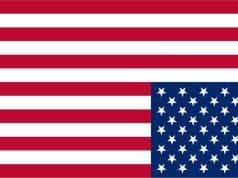


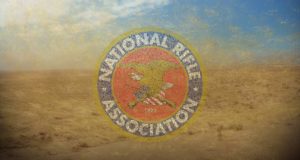
Tell me that the picture representing “Clean It” isn’t WD-40 and it isn’t spraying the stuff into the action via the hammer slot. Just tell me I was hallucinating. WD-40 is right up there with 3-in-1 oil as one of the worst “lubricants”. (Actually they’re both owned by the same company.) It’s great for getting water off your tools when they get wet, but not for lubrication. And the article specifically says don’t try to spray lubricant into the action, but the picture only re-enforces the bad practice.
Come on Ed, Marshall, Michael. I’m available if you need someone to better select supporting pictures for an article.
Perhaps the pic should have been labeled ‘do not do this”!
Uh…the caption reads ‘do NOT spray into the action”. He IS telling us what NOT to do.